Berninis Sculptures Were Some of the Best Examples of Art
Gian Lorenzo Bernini (1598-1680) was one of Italia'south near beloved and prolific artists. His career spans some seventy years and includes everything from fountains and vases to yard palazzi and office buildings. He designed churches, painted portraits, and sculpted major biblical scenes and famous busts for half dozen unlike popes. Though his mother was Neapolitan and his father Florentine, Bernini was almost connected to Rome, where he lived and worked nigh his unabridged life.
Some of Bernini'southward all-time-known works include the jaw-dropping collonade in forepart of St. Peter'due south Basilica, the Fountain of the Four Rivers in Piazza Navona, the immense baldachin over the loftier altar of St. Peter's Basilica, and the Ecstasy of Saint Teresa, among hundreds of other works of art scattered around Rome, Florence, and across.
A sculptor, painter, and architect, Bernini was ane of Rome's concluding true Renaissance men, though his work properly belongs to the Baroque period, which came but later the Renaissance and marked the abandonment of reason and rationality in favor of emotion, movement, drama, and occasionally excess. Bernini didn't invent the Baroque manner, but he certainly helped to popularize information technology and brand it one of the quintessential cultural expressions of 17th-century Italy. When yous call up of Rome today, it is his vision of Rome, both artistic and architectural, that springs to listen.
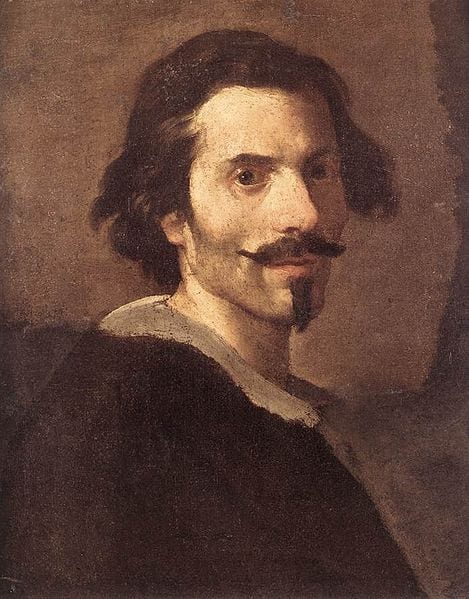
Gian Lorenzo Bernini'southward Self-portrait painted between 1630 and 1635. | Photo from the Galleria Borghese
Then how did Bernini create so many buildings and sculptures that remain amidst the meridian attractions in Rome to this day? The answers prevarication in his long and often wild life which was marked past extremes of passion and religious devotion. Learn where to see his most famous works equally well as the stories behind them below.
The child prodigy
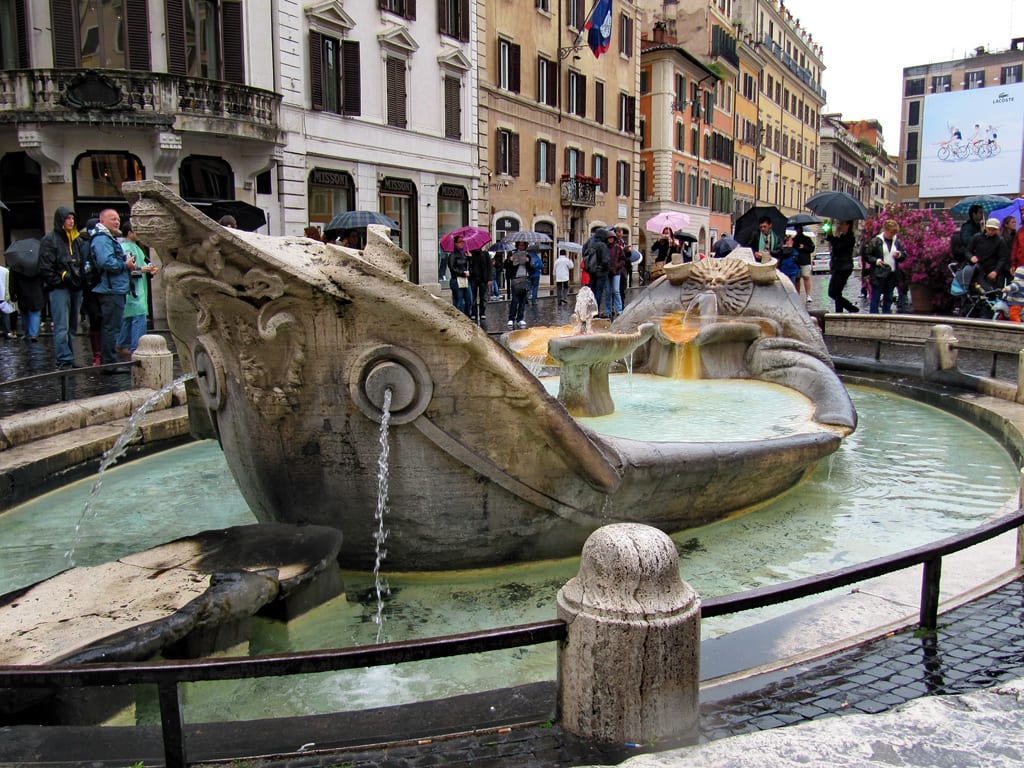
The Fontana della Barcaccia, virtually the Spanish Steps, was carved by Pietro, probably with assistance from his son, Gian Lorenzo Bernini. | Photo by Steve Johnson.
Bernini'due south father, Pietro, was a sculptor who tutored his son from an early age. When he was simply 8 years old Bernini's talent was recognized by none other than the Pope. With that kind of endorsement the artist gained widespread recognition chop-chop and establish himself winning commissions for major projects in his teens and early 20s.
To encounter the work of the young Bernini, cheque out theFontana della Barcaciaat the foot of the Castilian Steps. Although the official credit for the fountain goes to his father, it'southward widely believed that the young Bernini worked on it besides. Another of his great early on achievements was creating the colossal baldacchino in St. Peter's Basilica when he was still in his 20s. This immense altar canopy, which might be made from bronze pilfered from the roof of the Pantheon, is an extraordinarily effusive, dramatic, and some would say, over-the-top testament to the Barberini Pope Urban 8. Whether y'all love it or hate it, you tin't miss it.
The family man
Every bit the sixth of twelve siblings, Bernini must have been used to a large family. Later, he went on to accept xi children with his young wife, Caterina Tezio. Actually, Bernini was quite "old" (for the 17th century, that is) when he finally married in an arranged spousal relationship; He was 41 and his married woman was just 22.
These were non always great years for Bernini professionally. While he had been a favorite of the Barberini Pope Urban VII, his work came under attack when Innocent X (from the rival Pamphili) replaced Urban VII. If yous want to see Bernini's about famous work from these years yous'll have a tough time – He built 2 bell towers for the facade of St. Peter's Cathedral only cracks began to appear in them on the year he was married. Although he was after exonerated of whatever fault, both bell towers had to be torn down at a considerable cost to his prestige. Merely y'all tin can't keep a man like Bernini down forever. Later the bell-belfry debacle he came storming back to prominence past winning the committee for a fountain that was to be the main monument in the Pamphili family's newly remodeled plaza – the Piazza Navona. His cosmos, the Fountain of the Four Rivers, wowed everyone who saw it and remains one of the most visited attractions in Rome.
The Philanderer
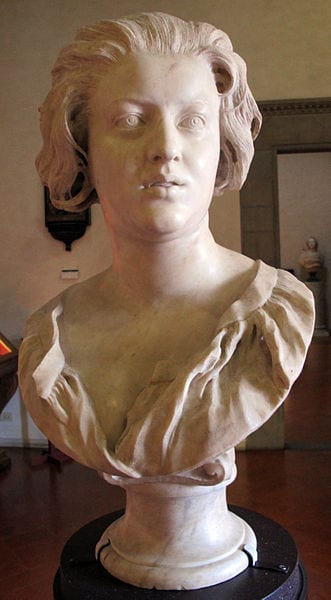
As many before and after her, Costanza Bonarelli became an creative person's mistress after posing as a model. | Photo by Sailko, via Wikicommons.
Before his marriage, Bernini had a passionate affair with a married adult female, Costanza Bonarelli. The wife of one of his administration, Bernini fell for her afterward she posed as his model. The sensual and suggestive bust sculpture of Costanza which he carved, with wavy hair, parted lips, and open up neckline, is a clear attestation to the artist'south passion for his subject.
It all came to a nasty stop when Bernini saw Costanza leaving the house of his brother, Luigi, 1 morning. The sculptor chased his blood brother with a crowbar, breaking bones before pursuing him with a sword. Though Luigi was spared after seeking refuge in Santa Maria Maggiore, a servant of Bernini was sent to Costanza'south habitation, where he slashed her face with a razor. Bernini was fined but ultimately forgiven by the Pope – he was as well important to the fine art world of the time. His servant took the blame, Luigi hid out for some fourth dimension, and information technology's said that Costanza not only recovered from the attack, but she eventually became a noted art dealer in Rome.
Oddly enough, the bust of Bernini's famous lover can't be found in Rome; it's in the Museo Nazionale del Bargello in Florence. To run into the artist's delineation of a similarly unhappy love affair, stop past the Borghese Gallery for a look at hisApollo and Daphne – a paradigm-irresolute delineation of a immature nymph turning into a tree to avoid the predations of the sun god, Apollo. As well in the gallery is the exquisite and centre-rendingPluto and Persephone, which depicts another licentious god – the eponymous Pluto – Kidnapping a terrified adult female to take dorsum to his abode in the underworld.
The devout Christian
Despite crow-barring his brother and sending an assassin with a razor blade after his lover, Bernini considered himself a devout Catholic. He attended mass daily, carried out spiritual exercises prescribed by the writings of St. Ignatius of Loyola, and routinely sought spiritual guidance from priests. His close friendship with the caput of the Jesuit gild likely exerted a heavy influence on his art, which can be seen especially toward the end of his career.
For some groovy examples of Bernini'south religious works, have notation of the statues of angels lining the Ponte Sant'Angelo as you brand your way over the Tiber towards the Vatican from Cardinal Rome. These Bernini-designed angels (which were actually carved past his students) were dubbed the "Informal Maniacs" presently after they were fashioned, manifestly because of the holy current of air that seems about to accident them off the bridge. The originals now sit down in Sant'Andrea delle Fratte.
The patriot
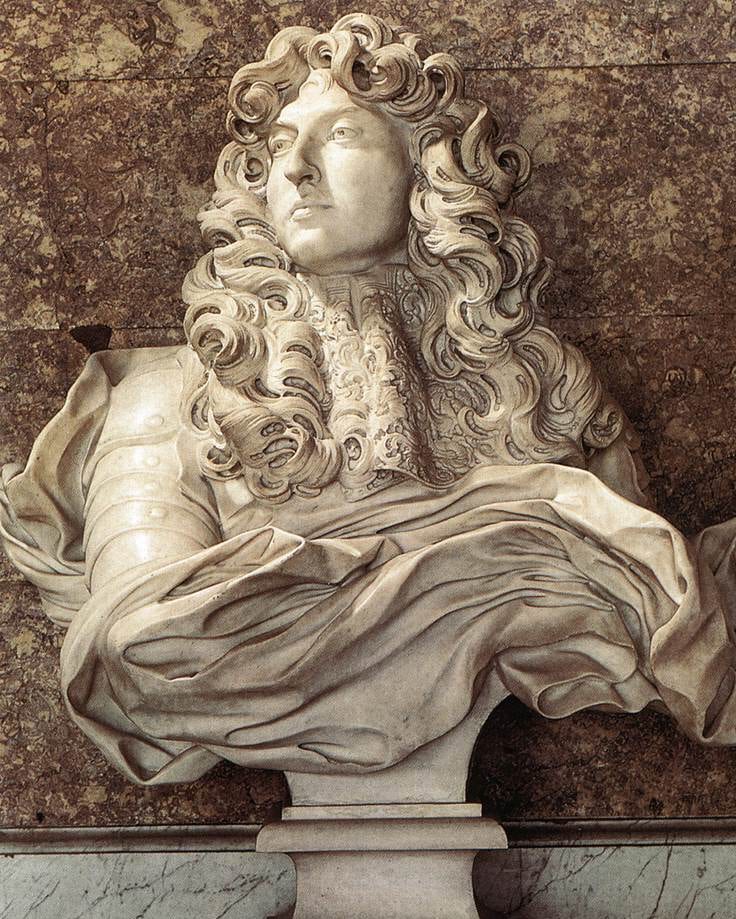
Bernini may not have enjoyed France simply he did manage to carve an amazing bust of King Louis XIV. | Photo by Louis le Thou
In 1665 Bernini went to Paris, France to consult on designs for the Louvre under Louis XIV – then the world'southward nigh powerful monarch. It was the only time since coming to Rome that Bernini left the city for more than a brief vacation. Less than six months after his arrival, he was already clamoring to return home. Apparently, he considered himself surrounded by cultural barbarians and constantly made comments to anyone within earshot regarding the inferiority of Paris when compared to Rome. As you might imagine, his beliefs didn't win him many friends – French friends, anyhow – and ultimately his designs were never used.
He did produce one slap-up piece of work from the trip, though. His bosom of King Louis 14 is widely considered among his finest sculptures, as well as existence a crowning instance of Bizarre art. It'south even more impressive considering that Bernini completed it in almost 40 days. Apparently, in between complaining near the French he managed to finagle nigh 20 sittings with the rex in which he studied the immature monarch and chipped abroad at the marble. Today the bust is on display at the Palace of Versailles.
The (Baroque) Renaissance man.
Bernini was about obscenely prolific with his art. As well defining the architecture and artistic style of Rome and Italy, Bernini as well wrote and staged multiple plays in the Barberini Palace Theater in Rome. Not but were the plays his own, he also acted in them. Most notable, even so, were his set designs and special effects – many of which were unheard of at the time. His plays featured rising platforms, flames that destroyed the set only to show some other behind it and floods from the Tiber River that threatened to drench the audience before disappearing downwards a hidden bleed.
One Englishman who witnessed Bernini'south spectacle wrote in his 1644 diary: "Bernini…gave a public opera wherein he painted the scenes, cutting the statues, invented the engines, equanimous the music, write the comedy, and built the theatre."
Although none of his phase designs accept survived, y'all tin appreciate the theatricality of Bernini'southward work in the Elephant Obelisk in front end of Santa Maria Sopra Minerva. Notice how the elephant is smiling and looking back, with its tail slightly to the side, as if about to, well, exit a "gift" for someone behind information technology? This was manifestly done on purpose: its hind end faces a nearby Dominican monastery that was the home of i of Bernini's rivals for the commission. When he came upwardly with the elephant, the rival claimed it would never support the weight of the obelisk and so the design was modified with a "saddlecloth" that hide a large stone support block. Bernini thought it ruined the awe that he had hoped to inspire with the design. In retribution, he oriented the defecating elephant's business end towards the monastery.
The creator of the most risqué religious sculptures in Christendom.
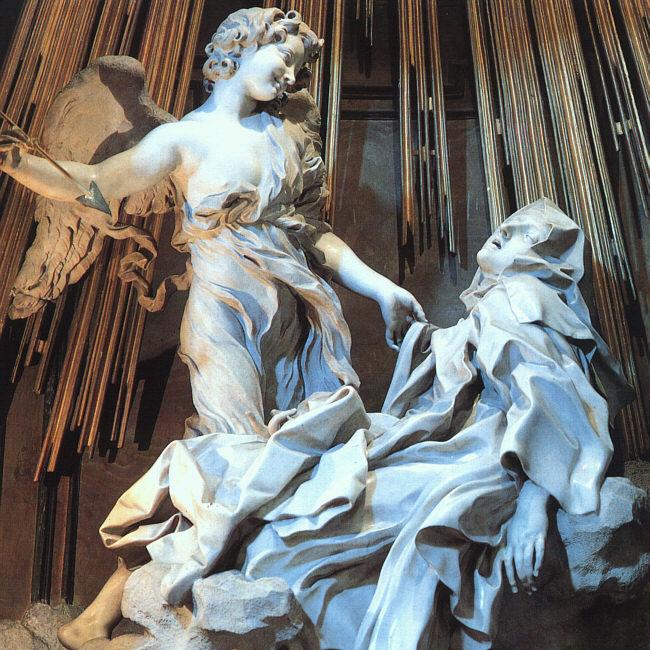
The Ecstasy of Saint Teresa was a articulate departure from the religious art of the by, but once critics overcame their daze, the sculpture came to be widely regarded every bit an infrequent delineation and work of art. | Photo by Napoleon Vier
Bernini pushed the humanistic and emotive way of Bizarre art to the extreme, shocking common people and connoisseurs alike. His fine art was sensual, extraordinarily lifelike, and scandalous compared to the Classical or Renaissance styles that hewed to strict rules about how religious figures could and shouldbe depicted.
Bernini's masterpiece, the Ecstasy of Saint Teresa is the culmination of this sensuous-to-the-indicate-of-blasphemy fashion. Located in the Cornaro Chapel in Santa Maria della Vittoria in Rome, it depicts an angel thrusting a spear into Saint Teresa's breast, bringing the swooning, rapturous saint into the clouds in a scene of ecstasy…ahem, religious ecstasy, that is. Nothing erotic to see here, no siree.
The statue is illuminated with golden sunbursts and natural lighting from subconscious windows that remind the viewer, once again, of Bernini's dearest of theater and stage design. Perhaps even more shocking than the Saint's clear physical ecstasy are the carved statues of Cornaro family unit members watching, as if in a theater. Merely then, they did committee the work.
Despite, or perhaps because of its obviously sexual tones, the scene is now one of the most celebrated religious sculptures in Rome, if not the globe. It is so striking, in fact, that the sculpture persuaded even the well-nigh hard-line skeptics of Bernini during his fourth dimension to concede that he was a unique talent in the Western earth.
Practice you have a favorite Bernini sculpture that nosotros've left out or are you curious to see more of his works in Rome? Let u.s.a. know in the comments.
mccrackenmashe1968.blogspot.com
Source: https://www.walksofitaly.com/blog/art-culture/things-to-see-in-rome-bernini